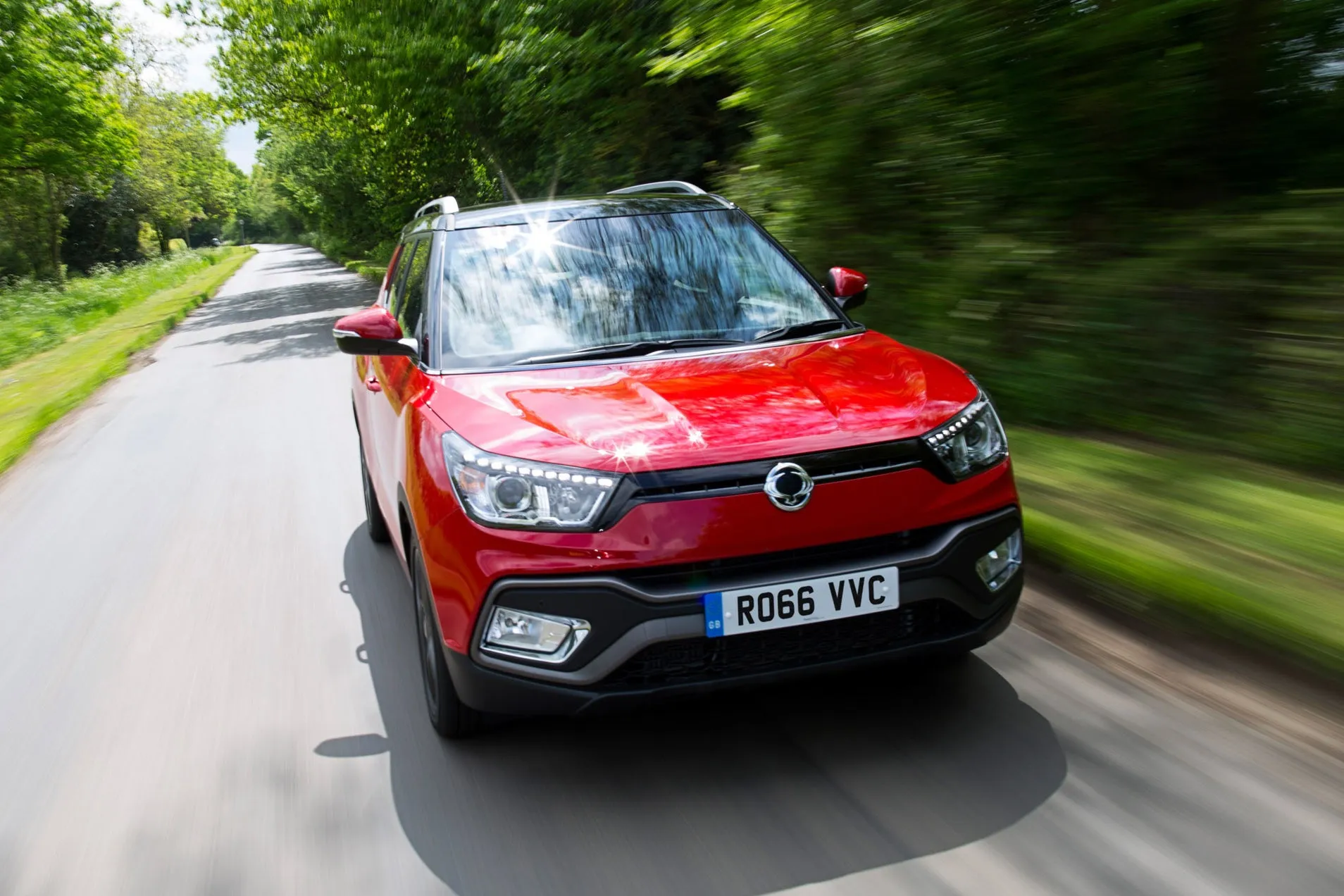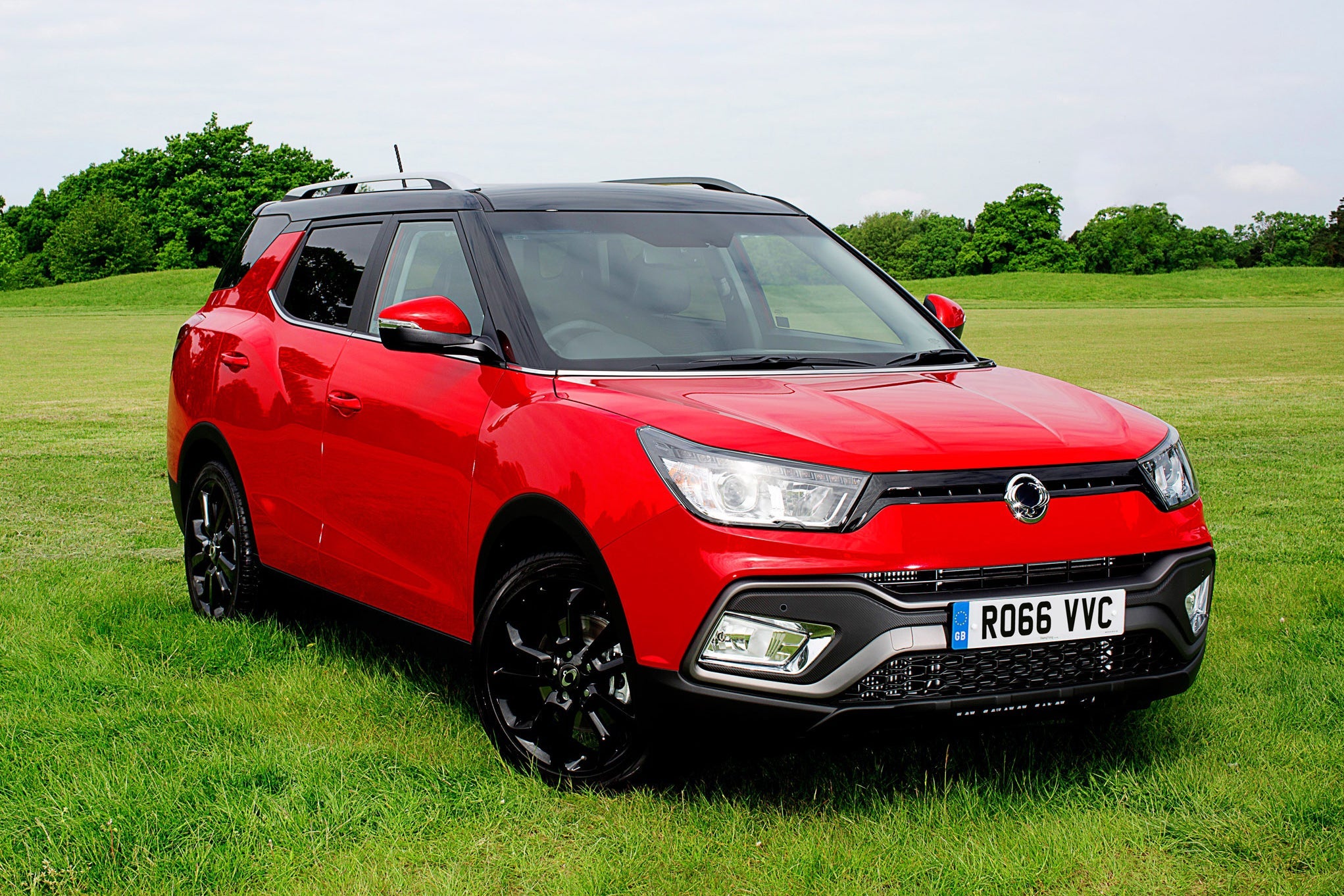SsangYong Tivoli XLV Review
Written by Andrew Brady
Quick overview
Pros
- Excellent value for money
- Massive boot
- Excellent warranty cover
Cons
- Noisy and inefficient engines
- Styling won’t be to all tastes
- SsangYong brand lacks appeal
Overall verdict
"The SsangYong Tivoli XLV falls just short of being one of the undiscovered gems of the crossover segment. The price, equipment, space and warranty are definite plus-points, but the car lacks refinement, efficiency and ultimate quality. It’s a good car, but not a great one."

SsangYong lacks the advertising budget and brand appeal of its major rivals, so the chances are you might not have heard of the Tivoli XLV. You might even struggle to spell the company name.
In the case of the Tivoli XLV, ignorance isn’t bliss. Few cars offer such a compelling blend of price, space and equipment, making this one of the best value cars of 2020. It comes tantalisingly close to being one of the industry’s undiscovered gems.
The XLV is a larger version of the SsangYong Tivoli crossover, with the extra space added to the back to create a kind of ‘SUV-estate’. XLV by name, extra-long vehicle by nature.
We think there are three, possibly four reasons why the Tivoli XLV is worth a look alongside the more established names you might consider. First, there’s the price, with the Tivoli XLV available for the cost of a mid-range family hatchback.
Then you need to consider the equipment, with SsangYong throwing all but the kitchen sink at the Tivoli XLV. Heated leather seats, 18-inch diamond-cut alloy wheels, a seven-inch touchscreen, Apple CarPlay, Android Auto, a heated steering wheel, front and rear parking sensors, cruise control and a suite of safety systems are just some of the highlights.
Practicality is another factor, with the Tivoli XLV offering estate car levels of luggage capacity and seats for five adults. The final factor working in the car’s favour is SsangYong’s excellent seven-year warranty, meaning your new Tivoli XLV will be covered until 2027.
You might be thinking that there has to be a catch. Well, you’re right. Take the styling. We think it looks pretty good from certain angles, especially following the 2019 facelift. The front looks upmarket, while the alloy wheels add a touch of class. However, there’s no disguising the rump, which at best looks awkward, but is bordering on ugly from some angles. One thing’s for certain: it doesn’t lack presence.
The 1.6-litre engines are another weak point. The petrol unit lacks punch, while the diesel engine is coarse and unrefined. Neither engine is particularly quick, while the CO2 emissions are far higher than you’d expect from a compact crossover in 2020. With decent engines, the Tivoli XLV would be a more attractive proposition.
Inside, it’s a bit of a mixed bag. The dashboard design is better than SsangYong models of old, but the centre console looks like it was inspired by a cheap hifi system from the 1990s. There’s also a curious mismatch of buttons and switches, along with the use of some questionable plastics.
The cabin quality is easier to forgive than the engines, but it’s clear where SsangYong has saved money to keep the list price to a minimum.
None of this detracts from what is a curiously appealing and credible crossover. If space, price and toys are your priorities, the SsangYong Tivoli XLV is worth a look. The price-to-equipment ratio makes a mockery of the cost of other crossovers. You might love it.
Is the SsangYong Tivoli XLV right for you?
If you’re after the maximum amount of space for the minimum amount of cash, and you’re not too bothered about image and a premium badge, the SsangYong Tivoli XLV is an interesting alternative to its mainstream rivals.
Although the ‘SUV-estate’ tag is a bit of a red herring – the XLV is basically a standard Tivoli crossover with a larger boot – this is a highly likeable car. You get the high driving position of an SUV with the load space of an estate, so maybe there’s some merit in the label after all.
It’s let down by a pair of inefficient and coarse engines, but it claws back some points thanks to a long list of standard equipment, a comprehensive warranty and some seriously low prices.
What’s the best SsangYong Tivoli XLV model/engine to choose?
Picking the best trim level is easy, because there’s only one. Sadly, it’s not called the ‘Highlander’ spec. It’s best to think of the Tivoli XLV as the flagship Tivoli, with SsangYong throwing everything but the kitchen sink at the equipment list.
As for the choice of engine, it makes sense to opt for the more powerful 1.6-litre diesel engine introduced in 2019. Although the manual version is a little less economical than before, the automatic is more efficient, while the additional punch is useful when travelling with a full load.
Choosing between the 1.6-litre petrol or 1.6-litre diesel is less clear-cut. The economy and performance offered by the petrol engine is woeful, especially in an era of efficient and punchy 1.0-litre turbocharged units, but it makes sense if you spend most of your time in town. The 1.6-litre diesel lacks refinement, but it’s the engine to choose if you spend a lot of time on the motorway.
What other cars are similar to the SsangYong Tivoli XLV?
The most obvious rival is the smaller and cheaper SsangYong Tivoli, which might make more sense if you don’t need the massive ‘snail house’ perched on the back of the XLV.
Otherwise you’re looking at the likes of the Dacia Logan MCV for boot space, the Suzuki Vitara for crossover appeal, and even the discontinued Skoda Roomster for slightly obscure practicality. SsangYong references the Nissan Qashqai as a rival, but the Tivoli XLV lacks the universal appeal of that popular crossover. It also cites the MINI Clubman, but the Tivoli XLV doesn’t have the quality or image to make it a credible competitor there.
Comfort and design
"Gone are the days when SsangYong interiors were about two decades behind the Europeans in terms of quality and design. Although the Tivoli XLV isn’t going to win any awards for imagination, it’s not the ‘bargain basement’ affair you might expect."

The centre console looks like it was inspired by a cheap hifi system from the 90s, complete with oddly thin buttons, a naff digital display for the climate control and bizarre rotary knobs for the heated seats. There’s also an odd mismatch of grey plastics that isn’t particularly easy on the eye.
You won’t struggle to find a decent driving position, with the steering wheel adjustable for height and reach, and the driver’s seat adjustable for height. It gets better, because leather upholstery, heated seats, a heated steering wheel and dual-zone climate control are standard equipment. Premium levels of kit for a bargain price.
It’s not perfect. The pedals are a little offset, which might cause some discomfort on a long journey, while you tend to sit ‘on’ the seats. This might seem like a strange thing to say in a car with a high driving position, it’s just that there’s an overriding sense of being perched when you’re driving the Tivoli XLV.
There’s no lumbar adjustment, while the seats lack lateral support, so you tend to move about when cornering. However, there’s a large, leather-clad centre armrest for your elbow, along with standard-fit cruise control, so the Tivoli XLV is surprisingly good for whiling away hours on a motorway journey.
Quality and finish
The Tivoli XLV is far better than SsangYong models of old, but it still flatters to deceive. The cabin is a pastiche of European and Japanese rivals with a look that’s too shiny and plastics that are too scratchy.
Without wishing to damn the Tivoli XLV with faint praise, it’s a good effort. Crucially, the touch-points boast a reassuringly upmarket feel, with the D-shaped steering wheel wrapped in leather and the interior door handles finished in chrome. It’s just a shame that the gear knob and automatic shift lever feel a bit cheap.
Things start to unravel when you prod the dashboard and door cards. The tops of the doors and the dashboard feel very cheap, while the piano black and dark grey inserts are hollow and plasticky. Does this matter? How often do you touch the dashboard?
The quality issue is offset by the level of equipment. The Tivoli XLV boasts keyless start, six colour options for the instrument cluster, electric front and rear windows, rain-sensing wipers, an auto-dimming rear-view mirror, cruise control, 18-inch diamond-cut alloy wheels, front and rear parking sensors, front and rear LED daytime running lights, automatic headlights and a cuddly toy. Okay, you don’t get a cuddly toy, but we’re sure the SsangYong dealer will let you have one if you ask nicely.
Infotainment
The SsangYong Tivoli boasts a seven-inch colour touchscreen infotainment system with DAB digital radio, iPod and Bluetooth connectivity and TomTom satellite navigation. Apple CarPlay and Android Auto are also fitted as standard.
It’s a comprehensive set-up, which also includes steering wheel mounted controls, six speakers including two tweeters, plus a rear-view camera.
The infotainment screen is simple to use, but while the display is clear, it lacks the clarity of rival systems. Switching to Apple CarPlay or Android Auto certainly helps, as the screen looks nicer and the system is faster to respond.
We also like the way SsangYong has positioned some of the key functions on buttons below the screen, while the steering wheel controls ensure that the system is easy to use without taking your eyes off the road ahead.
Space and practicality
We’ll start with the boot, because that’s the primary reason why you’d choose a Tivoli XLV over the Tivoli with less rump. We’d call the Tivoli XLV the ‘Kardashian’ version, but that might get us into trouble.
Basically, it’s huge. We’re talking about the Tivoli XLV’s boot, rather than anything to do with Ms. Kardashian. There’s 720 litres of luggage space available when all five seats are in use. That’s far more than the 423 litres you get in the standard Tivoli. We should point out that this figure is based on the floor to the roof, rather than the floor to the parcel shelf.
It’s also more than the 563 litres you get in the Dacia Logan MCV estate and the 660 litres of space in the Skoda Superb estate. In fact, 720 litres puts the Tivoli XLV on a par with the Audi Q7. Forget carrying a dog, you could transport an entire kennel in the Tivoli XLV.
The rear seats fold 60:40, with a cavernous 1,440 litres of space available if the back seats aren’t required. Entry to the boot is hampered by a high loading lip, while the wheelarches eat into the available space, but with so much space on offer, we don’t think this will cause too many problems.
A mini spare wheel is available as an option, but if you don’t need it you’ll have some additional underfloor storage in the boot. A luggage cover helps to keep your luggage away from prying eyes.
The back seats provide enough room for three adults, with plenty of headroom and legroom available. Even the middle-seat passenger will feel comfortable, with plenty of room for their feet. If the middle seat isn’t required, the centre armrest can be lowered to reveal a pair of cupholders. The storage straps on the backs of the front seats are a bit odd, but you might find a use for them.
Up front, there’s a pair of cupholders, a removable bin/ashtray, a large glovebox, a central storage bin with space for an iPad, a handy storage shelf on the dashboard, plus good size door pockets.
It’s just a shame that SsangYong didn’t use the opportunity to add a sliding function for the rear seats. With so much luggage space on offer, the Tivoli XLV could have offered limo-like levels of rear accommodation with sliding seats. A missed opportunity.
Handling and ride quality
"The Tivoli XLV has a mature and grown-up feel with a driving experience that prioritises comfort over enjoyment. It’s a credit to SsangYong that it feels very much like the standard Tivoli in this regard."

It features something called ‘Smart Steering’, which offers three modes: Comfort, Normal and Sport. In theory, Comfort lightens the steering for city driving and parking, while Sport makes it more responsive for a… well, sportier driving experience. In truth, you’ll struggle to notice the difference, although the Comfort mode does help a little when parking.
The extra weight over the standard Tivoli improves the ride quality, although the XLV does tend to crash over large potholes and imperfections. It’s far from uncomfortable, but it lacks the suppleness of its premium rivals. But then you’re not paying a premium price.
Less positive is the handling. It’s tidy enough, but if you enter a corner with a little too much enthusiasm, you’ll be greeted with plenty of body-roll and tyres that feel like they’re on the edge of adhesion.
We’re not going to criticise the Tivoli XLV for this, because few people will buy one of these to go hunting hot hatchbacks on a country road. Keep the Tivoli XLV within its limits and it’s a thoroughly pleasant and decent car to drive. It’s especially nice around town, where the high driving position, light steering and all-round excellent visibility combine to make it very easygoing.
Engines and gearboxes
If the SsangYong Tivoli XLV has a weak point, it’s the range of engines. There are two 1.6-litre engines available: a petrol and a turbocharged diesel. It’s a shame that the XLV doesn’t get the 1.2-litre three-cylinder petrol that’s available on the all-new Tivoli.
The 1.6-litre diesel in the XLV produces 115PS and 300Nm of torque to deliver a 0-62mph time of 12 seconds and a top speed of 106mph. Slow on paper, frustrating in reality. It takes an age to get up to speed, with the engine showing its displeasure if you attempt to hurry it along. It sounds coarse and lacks the refinement of other modern diesels.
In fairness, it’s far better at motorway speeds, but that’s not before you’ve endured its misery on the slip road. The six-speed manual gearbox is pleasant enough, while the automatic transmission changes gears smoothly and without fuss.
The 1.6-litre petrol produces a measly 128PS, which is nowhere near enough when you consider the output of modern 1.0-litre turbocharged engines. A figure of 160Nm also highlights the lack of torque, which will become evident if you attempt to make swift progress with five people and a boot full of luggage.
The manual version will take a leisurely stroll to 62mph in 12 seconds, before running out of puff at 106mph. The automatic version hits 62mph a second quicker, but falls 1mph short of 100mph. Oh dear. A four-wheel-drive version was available at launch, but has since been discontinued.
Refinement and noise levels
All things considered, the SsangYong Tivoli XLV feels reasonably refined, especially at motorway speeds. But ‘reasonably’ doesn’t mean great.
There’s a fair amount of wind noise at high speeds, while the tyres send a lot of road roar into the cabin. It can become tiring on a long journey.
Things are worse if you opt for the diesel engine. Not only is it one of the noisiest diesel engines in its class, it also sends vibrations through the steering wheel and pedals. If the Tivoli XLV had better engines, it would be fighting for class honours. Instead, it must rely on its price and equipment.
The Tivoli XLV also lacks the extra soundproofing and insulation you’d find in a more expensive crossover. Note the use of ‘more expensive’ – everything we say has to be viewed in the context of the Tivoli XLV’s low price.
Safety equipment
The SsangYong Tivoli XLV was awarded a credible four-star safety rating when it was crash-tested by Euro NCAP in 2016.
The individual figures are a mixed bag, with the XLV scoring 82 percent for adult occupant protection, 62% for child occupant protection, 65% for pedestrian safety, and 43% for safety assist systems.
That score for child occupant protection will ring alarm bells for parents who are considering strapping their children into a Tivoli XLV. On the plus side, there are two Isofix points in the back, but they’re quite difficult to locate.
You also get a good level of standard safety equipment, including seven airbags, forward collision warning with autonomous emergency braking, lane-departure warning, lane-keeping assist, traffic sign recognition and high beam assist. That’s an excellent list for a car at this end of the market.
Front and rear parking sensors, a rear-view camera, tyre pressure monitoring and speed-sensing door locks are also standard. However, the cruise control is a traditional system, rather than a modern adaptive cruise control. In other words, it doesn’t react to the speed and movement of other vehicles.
MPG and fuel costs
"Fuel economy isn’t a Tivoli XLV strong point. Don’t be fooled by the claimed figures of the earlier cars – the Tivoli XLV was hit hard by the switch from the old NEDC tests to the more realistic WLTP standard."

For example, the 1.6-litre diesel manual launched with a claimed 67.3mpg – an impressive figure. Today, the same car offers a claimed 51.4mpg. The engine is no less economical, it’s just that the testing procedure has changed.
The automatic transmission puts a massive dent in the diesel engine’s efficiency, with economy dropping to 42.8mpg. Still, this is better than the 37.2mpg offered by the 1.6-litre petrol manual and the 34.9mpg of the petrol automatic. Ouch.
Insurance groups and costs
The SsangYong Tivoli XLV is a cheap car to insure, with group ratings of 11 to 15. Curiously, this makes it slightly cheaper than the smaller SsangYong Tivoli, which slots into groups 13 to 16.
For some context, the new Dacia Duster slots into groups 9 to 15, the Suzuki Vitara groups 12 to 21, and the Dacia Logan MCV groups 2 to 12.
VED car tax
Thanks to the SsangYong Tivoli XLV’s less-than-brilliant CO2 figures, you’ll pay a fair amount of ‘showroom tax’. Opting for the 1.6-litre diesel with a manual gearbox will soften the blow. CO2 emissions of 144g/km mean a first-year rate of £540.
The 1.6-litre petrol with a manual gearbox emits 173g/km, which means first-year rate of £870. The CO2 emissions for the 1.6-litre diesel automatic are the same, but the diesel premium means a cost of £1,305. The 1.6-litre petrol automatic emits 184g/km, so the tax is £870.
These costs are included in the original purchase price, so you’ll pay a flat rate of £150 for Vehicle Excise Duty (VED) from year two. This is the same for all Tivoli XLV models registered since the car was introduced in 2016.
How much should you be paying for a used SsangYong Tivoli XLV?
"SsangYong Tivoli prices start from £9,000. For this budget you’ll get an early 2016 or 2017 car with up to 50,000 miles on the clock. If you’re after a cavernous load area, a long list of equipment and a relatively new number plate, the Tivoli XLV is hard to beat."

All new SsangYong vehicles registered from 1 October 2018 are covered by an excellent seven-year warranty, so it makes sense to buy a Tivoli XLV registered after this date. You’re looking at a minimum of £12,500 if you choose to go down this route.
Post-facelift cars start from £14,000, which is less than the price of a new Ford Fiesta. Remember, these cars are covered by a manufacturer’s warranty until 2026. Amazingly, even cars registered in 2020 are available for around £16,500. Following the herd isn’t always a good idea.
Trim levels and standard equipment
The Tivoli XLV is based on the Ultimate spec of the standard SsangYong Tivoli. As a result, pretty much everything comes as standard.
The list includes 18-inch diamond-cut alloy wheels, front and rear LED daytime running lights, a seven-inch touchscreen, Apple CarPlay, Android Auto, DAB digital radio, a rear-view camera, steering wheel controls, dual-zone climate control, keyless start, cruise control, leather seats, heated seats, a heated steering wheel, privacy glass, automatic wipers, automatic lights and electric windows.
There are five colours: Techno Grey, Silent Silver, Dandy Blue, Space Black and Grand White. Other colours were available in the past.
The list of accessories includes front and rear skid plates, a dog guard, a detachable tow bar, a heated screenwash system, a cycle carrier and – wait for it – carbon fibre C-pillar covers. We’re not sure many people have spent £350 on that option…
Get our latest advice, news and offers
Keep me updated by email with the latest advice, news and offers from heycar.
By submitting you agree to our privacy policy



